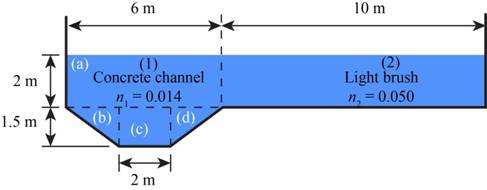
Concept explainers
The flow rate through the channel and the equivalent manning's coefficient.
Answer to Problem 54P
The flow rate is
Explanation of Solution
Given Information:
The figure below shows the cross -section of the channel.

Figure-(1)
The bottom slope of the channel is
Write the expression for flow rate.
Here, the manning's coefficient for channel 1 is
Write the expression for area of channel 1.
Here, the area of section a is
Write the expression to calculate the area of channel a.
Here, the breadth of section a is
Write the expression to calculate the area of channel b.
Here, the breadth of section b is
Write the expression to calculate the area of channel c.
Here, the breadth of section c is
Write the expression to calculate the area of channel d.
Here, the breadth of section d is
Write the expression to calculate the perimeter of the concrete channel.
Write the expression to calculate the perimeter of the light brush channel.
Here, the breadth of the light brush channel is
Write the expression to calculate the total perimeter.
Write the expression to calculate the equivalent hydraulic radius.
Write the expression to calculate the area of light brush channel.
Write the expression for total area.
Write the expression for hydraulic radius for channel 1.
Write the expression for the hydraulic radius for channel 2.
Write the expression for equivalent flow rate.
Here, the equivalent manning's coefficient is
Calculation:
Substitute
Substitute
Substitute
Substitute
Substitute
Substitute
Substitute
Substitute
Substitute
Substitute
Substitute
Substitute
Substitute
Refer to the Table (13.1), "Mean values of Manning coefficient for water flow open channels" to obtain the value of
Substitute
Substitute
Conclusion:
The flow rate is
Want to see more full solutions like this?
Chapter 13 Solutions
Fluid Mechanics: Fundamentals and Applications
- The flow rate of water flowing in a 5-m-wide channel is to be measured with a sharp-crested triangular weir 0.5 m above the channel bottom with a notch angle of 80°. If the flow depth upstream from the weir is 1.5 m, determine the flow rate of water through the channel. Take the weir discharge coefficient to be 0.60.arrow_forwardConsider the flow of water in a 10-m-wide channel at a rate of 70 m3/s and a flow depth of 0.80 m. The water now undergoes a hydraulic jump, and the flow depth after the jump is measured to be 2.4 m. Determine the mechanical power wasted during this jumparrow_forwardHow does uniform flow differ from nonuniform flow in open channels? In what kind of channels is uniform flow observed?arrow_forward
- Water flowing in a wide channel at a flow depth of 45 cm and an average velocity of 6.5 m/s undergoes a hydraulic jump. Determine the fraction of the mechanical energy of the fluid dissipated during this jump.arrow_forwardWater flows half-full through a 38-cm-diameter steel channel at an average velocity of 2.3 m/s. Determine the volume flow rate and whether the flow is subcritical or supercritical.arrow_forwardThe flow depth and velocity of water after undergoing a hydraulic jump are measured to be 1.1 m and 1.75 m/s, respectively. Determine the flow depth and velocity before the jump, and the fraction of mechanical energy dissipated.arrow_forward
- How is the total mechanical energy of a fluid during steady one-dimensional flow through a wide rectangular channel expressed in terms of heads? How is it related to the specific energy of the fluid?arrow_forwardWater is to be transported at a rate of 10 m3/s in uniform flow in an open channel whose surfaces are asphalt lined. The bottom slope is 0.0015. Determine the dimensions of the best cross section if the shape of the channel is (a) circular of diameter D, (b) rectangular of bottom width b, and (c) trap e zoidal of bottom width b.arrow_forwardIs it possible for subcritical flow to undergo a hydraulic jump? Explain.arrow_forward
 Elements Of ElectromagneticsMechanical EngineeringISBN:9780190698614Author:Sadiku, Matthew N. O.Publisher:Oxford University Press
Elements Of ElectromagneticsMechanical EngineeringISBN:9780190698614Author:Sadiku, Matthew N. O.Publisher:Oxford University Press Mechanics of Materials (10th Edition)Mechanical EngineeringISBN:9780134319650Author:Russell C. HibbelerPublisher:PEARSON
Mechanics of Materials (10th Edition)Mechanical EngineeringISBN:9780134319650Author:Russell C. HibbelerPublisher:PEARSON Thermodynamics: An Engineering ApproachMechanical EngineeringISBN:9781259822674Author:Yunus A. Cengel Dr., Michael A. BolesPublisher:McGraw-Hill Education
Thermodynamics: An Engineering ApproachMechanical EngineeringISBN:9781259822674Author:Yunus A. Cengel Dr., Michael A. BolesPublisher:McGraw-Hill Education Control Systems EngineeringMechanical EngineeringISBN:9781118170519Author:Norman S. NisePublisher:WILEY
Control Systems EngineeringMechanical EngineeringISBN:9781118170519Author:Norman S. NisePublisher:WILEY Mechanics of Materials (MindTap Course List)Mechanical EngineeringISBN:9781337093347Author:Barry J. Goodno, James M. GerePublisher:Cengage Learning
Mechanics of Materials (MindTap Course List)Mechanical EngineeringISBN:9781337093347Author:Barry J. Goodno, James M. GerePublisher:Cengage Learning Engineering Mechanics: StaticsMechanical EngineeringISBN:9781118807330Author:James L. Meriam, L. G. Kraige, J. N. BoltonPublisher:WILEY
Engineering Mechanics: StaticsMechanical EngineeringISBN:9781118807330Author:James L. Meriam, L. G. Kraige, J. N. BoltonPublisher:WILEY





